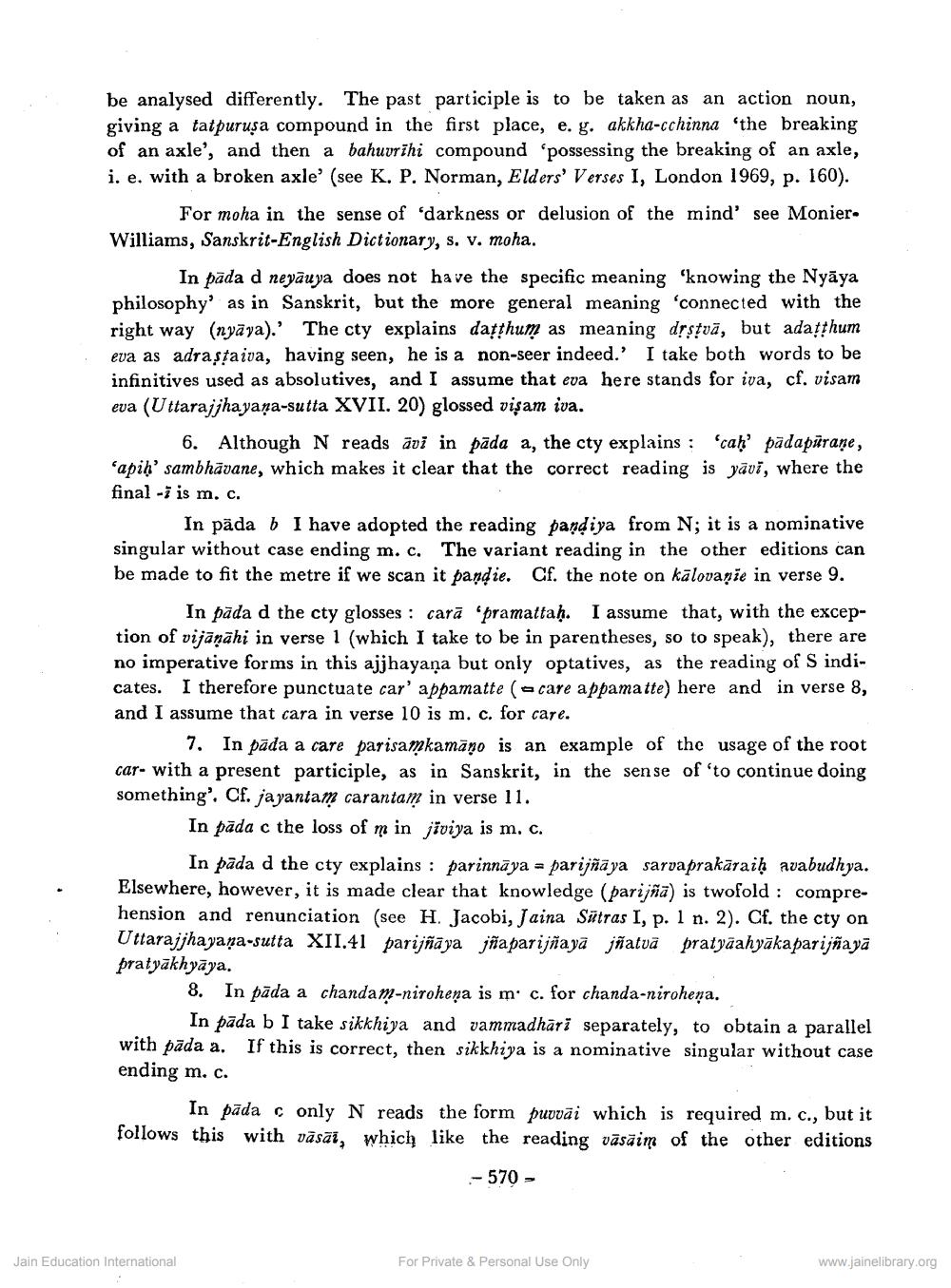________________
be analysed differently. The past participle is to be taken as an action noun, giving a tatpurusa compound in the first place, e. g. akkha-cchinna 'the breaking of an axle', and then a bahuvrihi compound possessing the breaking of an axle, i. e. with a broken axle' (see K. P. Norman, Elders' Verses I, London 1969, p. 160).
For moha in the sense of darkness or delusion of the mind' see Monier. Williams, Sanskrit-English Dictionary, s. v. moha.
In pada d neyāuya does not have the specific meaning 'knowing the Nyāya philosophy' as in Sanskrit, but the more general meaning 'connected with the right way (nyāya).' The cty explains datthum as meaning dệsțvā, but adatphum eva as adrastaiva, having seen, he is a non-seer indeed. I take both words to be infinitives used as absolutives, and I assume that eva here stands for iva, cf. visam eva (Uttarajjhayaņa-sutta XVII. 20) glossed viņam iva.
6. Although N reads avi in pada a, the cty explains : 'caņ' pädapärane, ‘apiņ' sambhāvane, which makes it clear that the correct reading is yāvī, where the final -7 is m. c.
In pada b I have adopted the reading pandiya from N; it is a nominative singular without case ending m. c. The variant reading in the other editions can be made to fit the metre if we scan it pandie. Cf. the note on kālovanie in verse 9.
In pāda d the cty glosses : carā 'pramattaḥ. I assume that, with the exception of vijānāhi in verse 1 (which I take to be in parentheses, so to speak), there are no imperative forms in this ajjhayana but only optatives, as the reading of Sindicates. I therefore punctuate car' appamatte ( care a ppamatte) here and in verse 8, and I assume that cara in verse 10 is m. c. for care.
7. In pāda a care parisamkamāno is an example of the usage of the root car- with a present participle, as in Sanskrit, in the sense of 'to continue doing something'. Cf. jayantam carantam in verse 11.
In pāda c the loss of m in jiviya is m. c.
In pada d the cty explains : parinnāya = parijñāya sarvaprakāraih avabudhya. Elsewhere, however, it is made clear that knowledge (parijñā) is twofold: comprehension and renunciation (see H. Jacobi, J aina Sätras I, p. 1 n. 2). Cf. the cty on Uttarajjhayana-sutta XII.41 parijñāya jña parijñayā jñatvā pratyäahyāka parijñayā pratyākhyāya.
8. In pāda a chandam-niroheňa is m: c. for chanda-nirohena.
In pāda b I take sikkhiya and vammadhāri separately, to obtain a parallel with pāda a. If this is correct, then sikkhiya is a nominative singular without case ending m. C.
In pāda c only N reads the form puvvāi which is required m. c., but it follows this with vāsāt, which like the reading vāsāim of the other editions
- 570 -
Jain Education International
For Private & Personal Use Only
www.jainelibrary.org




